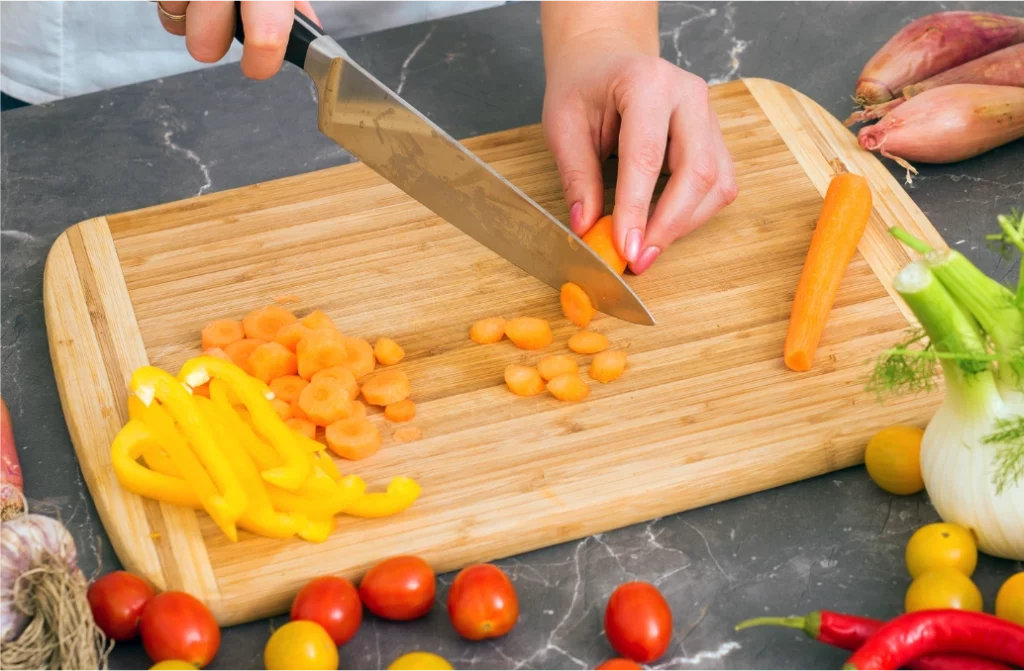
The Best Cutting Boards for Your Knives.
Selecting the best cutting board for your knives is critical when shopping for a board. The boards protect your countertops from scratches and damage caused by knives and provide a stable surface for cutting fruits, vegetables and meats. However, not all cutting boards are created equal. Coming in a variety of materials, each has its own distinct perks and drawbacks. In this article, we’ll discuss the different styles of cutting boards and which is most suitable for protecting and maintaining the delicate edges of your knives.
-
Wood Cutting Boards
Wood cutting boards are the most traditional and popular type of cutting board. They are made from hardwoods such as maple, cherry, and walnut. Wood cutting boards have a natural beauty and warmth that many people find appealing. They are also durable and can last a lifetime if properly cared for.
When it comes to using knives, wood cutting boards are a great choice because they are relatively soft and forgiving. They do not dull knives as quickly as harder surfaces like glass or stone. The natural fibers in the wood also help to absorb the impact of the knife, which can reduce the risk of chipping or breaking the blade.
However, wood cutting boards do require some maintenance to keep them in good condition. After each use, they should be washed with mild soap and warm water and dried thoroughly to prevent warping or cracking. They should also be oiled regularly with food-grade mineral oil, like Thirteen Chefs Foods Grade Mineral Oil, to keep the wood from drying out and to maintain their natural beauty.
And when it comes to wood cutting boards, there are three types: end grain, top grain and side grain cutting boards.
 End grain cutting boards, like the highly rated John Boos Maple Classic Reversible Wood End Grain Chopping Block, are made by gluing together the ends of small pieces of wood, resulting in a checkerboard pattern on the surface. They are highly durable and gentle on knives because the knife’s edge goes between the wood fibers rather than cutting across them, and therefore, it is “self-healing” – as the blade pulls out of the board, the fibers push back together. However, they can be more expensive and require more maintenance.
End grain cutting boards, like the highly rated John Boos Maple Classic Reversible Wood End Grain Chopping Block, are made by gluing together the ends of small pieces of wood, resulting in a checkerboard pattern on the surface. They are highly durable and gentle on knives because the knife’s edge goes between the wood fibers rather than cutting across them, and therefore, it is “self-healing” – as the blade pulls out of the board, the fibers push back together. However, they can be more expensive and require more maintenance.
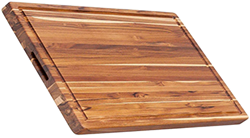 Edge grain boards, like the TeakHaus Edge Grain Cutting Board, are made by gluing together long strips of wood with the grain running parallel to the surface. They are less expensive than end grain boards and slightly less gentle on knives. They tend not to be as durable. Edge grain cutting boards tend to get more cut marks than end grain boards. This is because you are cutting across the wood fibers and those marks can’t heal themselves.
Edge grain boards, like the TeakHaus Edge Grain Cutting Board, are made by gluing together long strips of wood with the grain running parallel to the surface. They are less expensive than end grain boards and slightly less gentle on knives. They tend not to be as durable. Edge grain cutting boards tend to get more cut marks than end grain boards. This is because you are cutting across the wood fibers and those marks can’t heal themselves.

Side grain cutting boards, also known as face grain boards, like this beautiful AZRHOM XL Large Walnut Wood Cutting Board, are made by gluing together large pieces of wood with the grain running perpendicular to the surface. They are the least expensive type of cutting board and are easy to maintain. However, they are also the harder on knives, show knife marks faster and may need to be replaced more often.
When choosing the best cutting board for your knives, it’s also important to consider your budget, how often you plan to use the board, and how much maintenance you are willing to put into it. End grain cutting boards are the most durable and gentle on knives and are highly recommended, but they are also the most expensive and require the most maintenance. Top grain and side grain cutting boards are less expensive and easier to maintain, but they may not last as long or be as gentle on knives.
-
Plastic Cutting Boards
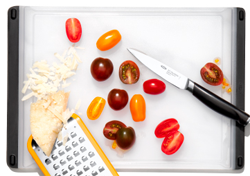 Plastic cutting boards, like the OXO Good Grips Plastic Utility Cutting Board, are another popular choice. They are lightweight, affordable and easy to clean. They come in a variety of colors and sizes, making it easy to designate specific boards for different types of foods to prevent cross-contamination.
Plastic cutting boards, like the OXO Good Grips Plastic Utility Cutting Board, are another popular choice. They are lightweight, affordable and easy to clean. They come in a variety of colors and sizes, making it easy to designate specific boards for different types of foods to prevent cross-contamination.
When using knives, plastic cutting boards are not as forgiving as wood boards. They are harder and can dull knives more quickly. They also tend to develop deep grooves over time, which may harbor bacteria and make them difficult to clean.
However, plastic cutting boards are dishwasher safe, which makes them convenient for busy households. They are also non-porous, which means they do not absorb liquids and are less likely to harbor bacteria than wood boards.
-
Bamboo Cutting Boards
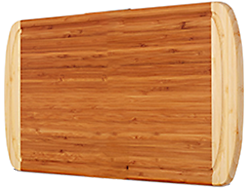 Bamboo cutting boards, like this Organic Extra Large Bamboo Cutting Board with Lifetime Replacements, have become increasingly popular in recent years. They are made from a renewable resource and are eco-friendly. They are also durable and have a natural beauty that is similar to wood.
Bamboo cutting boards, like this Organic Extra Large Bamboo Cutting Board with Lifetime Replacements, have become increasingly popular in recent years. They are made from a renewable resource and are eco-friendly. They are also durable and have a natural beauty that is similar to wood.
When using knives, bamboo cutting boards are harder than wood, attributed to a high percentage of silica. and can damage the blade of your knife, especially when it is made of softer steel. They dull the hardest Japanese knives; hence, are not commonly recommended to professionals, and they are not as durable as wood boards and may develop cracks or splits over time.
Bamboo cutting boards should be washed with mild soap and warm water after each use and dried thoroughly to prevent warping or cracking. They should also be oiled regularly with mineral oil to maintain their natural beauty.
-
Glass Cutting Boards
 Glass cutting boards, like the Murrey Home Tempered Glass Cutting Board, are a popular choice for many people because they are easy to clean and sanitize. They are also durable and do not develop deep grooves like plastic boards. Glass cutting boards come in a variety of colors and designs, making them a stylish addition to any kitchen.
Glass cutting boards, like the Murrey Home Tempered Glass Cutting Board, are a popular choice for many people because they are easy to clean and sanitize. They are also durable and do not develop deep grooves like plastic boards. Glass cutting boards come in a variety of colors and designs, making them a stylish addition to any kitchen.
When it comes to using knives, glass cutting boards are a terrible choice. They are too hard and will quickly dull knives. They can also chip or crack if they are dropped or exposed to extreme temperatures. If you need to stack the board when storing, place a soft cloth or piece of felt between it and other items to protect it.
Glass cutting boards should be washed with mild soap and warm water after each use and dried thoroughly. They should be handled with care to prevent chipping or cracking.
-
Stone Cutting Boards
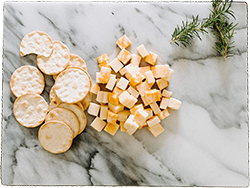 Stone cutting boards, such as granite or marble, like the Villa Acacia Marble Cutting Board, are a luxurious and elegant addition to any kitchen. They are extremely durable and can last for many years if properly cared for.
Stone cutting boards, such as granite or marble, like the Villa Acacia Marble Cutting Board, are a luxurious and elegant addition to any kitchen. They are extremely durable and can last for many years if properly cared for.
When it comes to using knives, stone cutting boards are not a good choice. They are too hard and will quickly dull knives and cause them to chip or break. Stone cutting boards also tend to be heavy and difficult to maneuver, making them less practical for everyday use.
Stone cutting boards should be washed with mild soap and warm water after each use and dried thoroughly. They should also be sealed regularly to prevent stains and discoloration.
-
Composite Cutting Boards
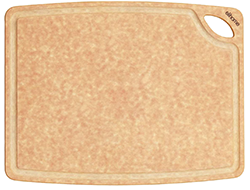 Composite cutting boards, like the Elihome Natural Wood Fiber Composite Cutting Board, are made from a mixture of materials, such as wood fibers and resin. They are designed to have the best features of both wood and plastic cutting boards.
Composite cutting boards, like the Elihome Natural Wood Fiber Composite Cutting Board, are made from a mixture of materials, such as wood fibers and resin. They are designed to have the best features of both wood and plastic cutting boards.
When it comes to using knives, composite cutting boards are a good choice. They are relatively soft and forgiving like wood, but also have the non-porous surface of plastic. They are also durable and resistant to warping, cracking and staining.
Composite cutting boards should be washed with mild soap and warm water after each use and dried thoroughly. They are also dishwasher safe, making them convenient for busy households.
Which Cutting Board is Best for Knives?
When choosing a cutting board that is best for knives, wood (especially end grain) cutting boards wood is the top choice. It is relatively soft and forgiving, which can help to prolong the life of your knives. They also have a natural beauty that many people find appealing.
Plastic and composite cutting boards can be decent choices, but they can be harder on knives than wood boards. Glass and stone cutting boards should be avoidedat all costs because they are too hard and can quickly dull knives.
Regardless of which type of cutting board you choose, it is important to take care of it to maintain its quality and prevent the spread of bacteria. All cutting boards should be washed with mild soap and warm water after each use and dried thoroughly. Wood and bamboo cutting boards should also be oiled regularly to prevent drying and cracking.
In conclusion, there are several types of cutting boards to choose from, each with its own unique benefits and drawbacks. When it comes to using knives, wood (especially end grain) and bamboo cutting boards are the best choices because they are relatively soft and forgiving, especially when using Japanese knives, which are incredibly sharp, but are more brittle and likely to chip if not used properly. Plastic and composite cutting boards are also decent choices, but glass and stone cutting boards should be avoided. Regardless of which type of cutting board you choose, taking proper care of it will help to ensure its longevity and protect your knives from damage.
This is so helpful! Thank you.